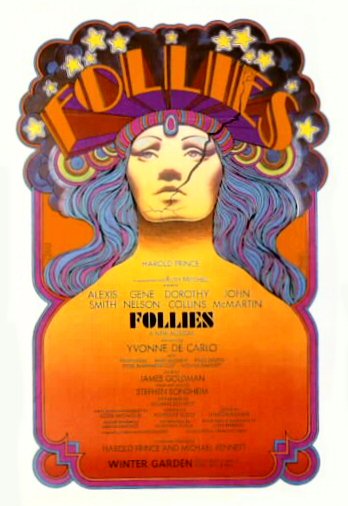"Follies" and "A Chorus Line"
 Image via Wikimedia CommonsThis summer I took a course on Stephen Sondheim. We focused on five shows: Company, Follies, A Little Night Music, Sweeney Todd and Into the Woods. One of the requirements was to write journal reflections about something we talked about in class, or expanding on something. Below is one I wrote - in the form I turned in - talking about similarities between Follies and A Chorus Line. It's not hard research, so there may be a few minor errors (and, truthfully, I ripped most of this out on a late night 2-hour car ride to Chicago, with some additions and edits made later). I also tried to keep it brief; the reflections weren't supposed to be more than 500 words, but this ended up being 700+. I think there's more in here that can be studied and discussed, and if the opportunity presents itself this semester, I hope to have time to expand upon some of the ideas below.
Image via Wikimedia CommonsThis summer I took a course on Stephen Sondheim. We focused on five shows: Company, Follies, A Little Night Music, Sweeney Todd and Into the Woods. One of the requirements was to write journal reflections about something we talked about in class, or expanding on something. Below is one I wrote - in the form I turned in - talking about similarities between Follies and A Chorus Line. It's not hard research, so there may be a few minor errors (and, truthfully, I ripped most of this out on a late night 2-hour car ride to Chicago, with some additions and edits made later). I also tried to keep it brief; the reflections weren't supposed to be more than 500 words, but this ended up being 700+. I think there's more in here that can be studied and discussed, and if the opportunity presents itself this semester, I hope to have time to expand upon some of the ideas below.
Similar to my journal entry about Company, I want to briefly explore an angle of Follies that I haven’t seen discussed in published writings: the notion that Sondheim’s Follies influenced a musical created a few years later, A Chorus Line. Both shows are heavily indebted to the show business plots of earlier musical comedies, though they offer a different perspective than the musical comedies of the 1920s and 1930s. Both shows share some musical foundations and are closely connected with Michael Bennett, the co-director and choreographer of Follies and the creative mind responsible for much of A Chorus Line.
The most obvious connection, which while unusual isn’t unique, is that both shows are performed without intermission (although an intermission was added in later productions of Follies). Marvin Hamlisch has talked about how an intermission would interrupt the flow of the story in A Chorus Line, and the same argument can be made for Follies, where – when performed with an intermission – the second act starts exactly where the first act ended, interrupting the dramatic tension created by the embrace between Ben and Sally.
There are other connections between the two shows that lie further under the surface, hinting that even if A Chorus Line wasn’t directly and clearly influenced by Follies, it owes a debt to the show that came five years prior to its conception and production. Many musicals have a show business plot; it was a standard plot device in musical comedies of the 1920s, and is found in earlier Sondheim shows like Gypsy. Follies and A Chorus Line revolve around a show business plot and atmosphere, but they do not feature an optimistic view of show business like many musical comedies. Instead, these shows give a more realistic look at the musical theatre world – some might say pessimistic at times – showing the tolls that show business can take on performers. A key difference between the shows is that A Chorus Line features current performers auditioning for a Broadway musical, while Follies focuses on retired performers who haven’t been on stage in forty years.
 Image via chorusline.orgIn Finishing the Hat and Sondheim and Co., Sondheim and Bennett talk about the choreography of “Who’s That Woman?” Sondheim wanted Bennett to choreograph it with an obvious hole, representing a sixth chorus girl from the original Follies cast who had since passed away. Bennett liked the idea, but it didn’t work in execution. Instead, Bennett had the six older ladies joined by their younger counterparts, “mirror-costumed.” Bennett later used Sondheim’s idea of a missing dancer in A Chorus Line, when Paul has to leave the auditions because of a leg injury. (Incidentally, there is another small connection between “Who’s That Woman?” and A Chorus Line in the song “Music and the Mirror,” which both use the symbolism of a mirror and dancing, albeit to different ends.)
Image via chorusline.orgIn Finishing the Hat and Sondheim and Co., Sondheim and Bennett talk about the choreography of “Who’s That Woman?” Sondheim wanted Bennett to choreograph it with an obvious hole, representing a sixth chorus girl from the original Follies cast who had since passed away. Bennett liked the idea, but it didn’t work in execution. Instead, Bennett had the six older ladies joined by their younger counterparts, “mirror-costumed.” Bennett later used Sondheim’s idea of a missing dancer in A Chorus Line, when Paul has to leave the auditions because of a leg injury. (Incidentally, there is another small connection between “Who’s That Woman?” and A Chorus Line in the song “Music and the Mirror,” which both use the symbolism of a mirror and dancing, albeit to different ends.)
Musically, there isn’t a clear debt that A Chorus Line has to Follies, but there are similarities and consistencies. Follies mostly consists of pastiche numbers of the 1920s and 1930s, while A Chorus Line is heavily inflected by rock and pop styles of the 1970s. Jonathan Tunick was the orchestrator for Follies and orchestrated some parts of A Chorus Line, but the orchestrations for A Chorus Line sounds more like that of Sondheim’s Company than Follies. One similarity involves the final production number of A Chorus Line ("One" and "Bows"). The number was intentionally intended to be a pastiche of a “showstopper” number from earlier revues and musical numbers. The cast is dressed in glittering white tuxedos and top hats and dances extravagantly. "One" might be more clichéd than the pastiche numbers in Follies, perhaps bringing to mind a Rockettes feature instead of Porter and Gershwin songs, and not be as directly indebted to specific composers and lyricists as Sondheim says his songs are, but the connection to musical theatre history is apparent.
That Michael Bennett was heavily involved in the original production of Follies and later went on to conceive, choreograph and direct A Chorus Line indicates that some ideas generated during Follies likely transferred to the creation and production of A Chorus Line. Direct lineage is not readily evident, but I think this idea has some merit, and A Chorus Line probably would not have taken the same form as it did were Follies not to have preceded it.
My prof responded that if he were doing a course on musicals of the 1970s, these two would be his main focus and starting point. He also pointed out - which I'll probably steal for my own jumping off point - that both shows deal with recognition, except in A Chorus Line it's to come together at the end, while in Follies the characters part ways and never see each other again.
